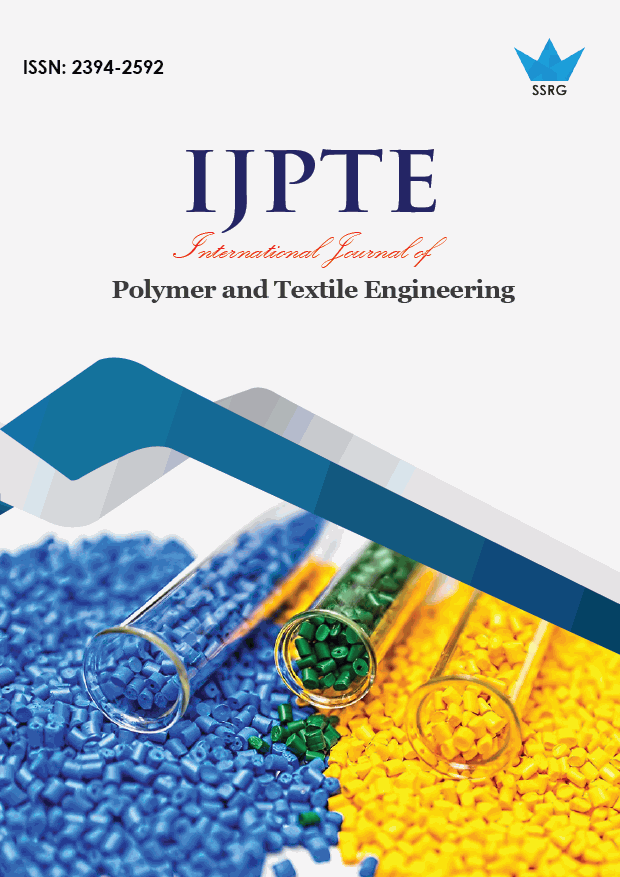Dyeing and Thermal Behavior of Ethyl Acrylate and 2- Hydroxyethyl Methacrylate-Modified Jute Fibres

| International Journal of Polymer and Textile Engineering |
| © 2023 by SSRG - IJPTE Journal |
| Volume 10 Issue 3 |
| Year of Publication : 2023 |
| Authors : Md. Ibrahim H. Mondal, Amjad Hossen, Md. Hasinur Rahman |
How to Cite?
Md. Ibrahim H. Mondal, Amjad Hossen, Md. Hasinur Rahman, "Dyeing and Thermal Behavior of Ethyl Acrylate and 2- Hydroxyethyl Methacrylate-Modified Jute Fibres," SSRG International Journal of Polymer and Textile Engineering, vol. 10, no. 3, pp. 6-11, 2023. Crossref, https://doi.org/10.14445/23942592/IJPTE-V10I3P102
Abstract:
This paper deals with the effect of dyeing and thermal behavior of ethyl acrylate and 2-hydroxy ethyl methacrylate-modified bleached jute fibre in a K2S2O8/FeSO4 redox system. The graft yield increased with the increase of monomer, initiator, and reaction time up to certain values, and then it decreased. Under optimum conditions, the highest graft yield for EA-modified and 2-HEMA-modified bleached jute fibre was 22.5% and 24.79%, respectively. Fourier Transform Infrared Spectroscopy was used to confirm the presence of monomers on the treated jute fibre. Thermogravimetric analysis was used to study the thermal behavior of the modified fibre. It is observed that jute fibre dyed with Reactive Orange 14 and Direct Blue 1 exhibited better colour fastness on exposure to sunlight in the air than dyed with Reactive Brown 10 and Direct Orange 1. Modified jute fibre showed improved thermal and mechanical stability as well as dyeability the fibre.
Keywords:
Jute fibre, Grafting, Ethyl Acrylate, 2-Hydroxy Ethyl-Methacrylate
References:
[1] Navin Chand, and Mohammed Fahim, Tribology of Natural Fiber Polymer Composite, 2 nd ed., Woodhead Publishing Series in Composites Science and Engineering, pp. 111-130, 2020.
[CrossRef] [Google Scholar] [Publisher Link]
[2] M.H. El-Rafie et al., “Grafting of Methacrylic Acid to Loomstate Viscose Fabric Using KMnO4/NaHSO3 System,” Polymers and Polymer Composites, vol. 2, no. 2, 1994.
[CrossRef] [Google Scholar] [Publisher Link]
[3] M.A. Rahman Bhuiyan et al., “Investigation on Dyeing Performance of Basic and Reactive Dyes Concerning Jute Fiber Dyeing,” Journal of Natural Fibers, vol. 13, no. 4, pp. 492-501, 2016.
[CrossRef] [Google Scholar] [Publisher Link]
[4] M.A. Sayeed et al., “Dyeing of Raw and Bleached Jute with Catechu Brown Dye,” Rajshahi University Studies Part B, vol. 15, pp. 1-17, 1987.
[Google Scholar]
[5] International Standard ISO 105-BO3-1978 (E), Textile-Tests for Colour Fastness – Part BO3: Colour Fastness to Weathering: Outdoor Exposure, International Organization for Standardization, 1978. [Online]. Available: https://www.iso.org/obp/ui/#iso:std:iso:105:- B03:ed-5:v1:en
[6] Mubarak A. Khan, and Lawrence T. Drzal, “Characterization of 2-Hydroxyethyl Methacrylate (HEMA)-Treated Jute Surface Cured by UV Radiation,” Journal of Adhesion Science and Technology, vol. 18, no. 3, pp. 381-393, 2004.
[CrossRef] [Publisher Link]
[7] Sailes Mukhopadhyay, Jagdish Prasad, and Satya R. Chatterjee, “Grafting of Acrylic Acid Onto Methylcellulose,” Macromolecular Chemistry and Physics, vol. 176, no. 1, pp. 1-7, 1975.
[CrossRef] [Google Scholar] [Publisher Link]
[8] Sandra Wohlhauser et al., “Grafting Polymers from Cellulose Nanocrystals: Synthesis, Properties, and Applications,” Macromolecules, vol. 51, no. 16, pp. 6157−6189, 2018.
[CrossRef] [Google Scholar] [Publisher Link]
[9] Rajani K. Samal, Sabyasachi Dash, and Atish K. Swain, “Graft Copolymerization of Methyl Acrylamide Onto Jute Fibers Initiated by Peroxydisulfate Catalyzed by Fe (III),” Polymer Journal, vol. 21, pp. 821-828, 1989.
[CrossRef] [Google Scholar] [Publisher Link]
[10] A. Hebeish et al., “Oxidation of Maize and Rice Starches Using Potassium Permanganate with Various Reductants,” Polymer Degradation and Stability, vol. 43, no. 3, pp. 363-371, 1994.
[CrossRef] [Google Scholar] [Publisher Link]
[11] Erika Mohanty, and B.C. Singh, “Graft Copolymerization of Methyl Methacrylate Onto Jute Fiber Initiated by Cerium (IV)–DMSO Redox Initiator System,” Journal of Applied Polymer Science, vol. 69, no. 13, pp. 2569-2576, 1998.
[CrossRef] [Google Scholar] [Publisher Link]
[12] N. Siti Syazwani et al., “Analysis on Extracted Jute Cellulose Nanofibers by Fourier Transform Infrared and X-Ray diffraction,” Journal of Building Engineering, vol. 48, 2022.
[CrossRef] [Google Scholar] [Publisher Link]
[13] Gaurav Sharma et al., “Graft Copolymerization of Acrylonitrile and Ethyl Acrylate onto Pinus Roxburghii Wood Surface Enhanced Physicochemical Properties and Antibacterial Activity,” Journal of Chemistry, vol. 2020, pp. 1-16, 2020.
[CrossRef] [Google Scholar] [Publisher Link]
[14] Zhou Chunxiao et al., “Functional Modification of Jute Fiber by Enzymatic Grafting of Gallate Esters,” Chemical Engineering Transactions, vol. 62, pp. 193-198, 2017.
[CrossRef] [Google Scholar] [Publisher Link]
[15] Fedor Ivanovich Sadov, Mikhail Vladimirovich Korchagin, and A. Matetsky, Chemical Technology of Fibrous Materials, MIR Publishers, Moscow, Rassia, 1978.
[Google Scholar] [Publisher Link]
[16] Sweety Shahinur et al., “Current Development and Future Perspective on Natural Jute Fibers and Their Biocomposites,” Polymers, vol. 14, no. 7, pp. 1-32, 2022.
[CrossRef] [Google Scholar] [Publisher Link]

 10.14445/23942592/IJPTE-V10I3P102
10.14445/23942592/IJPTE-V10I3P102